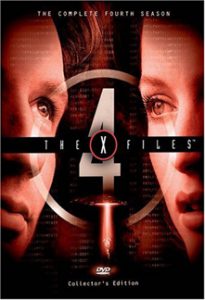Ideally for the business people behind the networks, TV series would be written in such a way that they could stay on the air forever. This is why sitcoms are popular with networks; people can start watching at any time without feeling lost. It’s also why a beginning-middle-end story — the “X-Files” mythology for example — is a problem. How can you build toward an ending when you don’t know if the show is going to be on the air for one, five or 10 more years?
Milking the mythology
If “The X-Files” story had been told without the business of TV lurking behind it, Season 4 would’ve been the road toward resolution. However, Chris Carter decided to milk the mythology in order to drag out the story out, and Season 4 (1996-97, Fox) is the year of treading water. We learn that the government conspirators are breeding bees and the Russians are experimenting with the alien black oil, and that’s about it.
And yet, almost in spite of themselves, these are some of the best mythology episodes of the series. The notes are the same as before, but they’ve never before been played so expertly. There’s a stylistic grandeur to it all, and I think Laurie Holden’s performance as new character Marita Covarrubius is a case in point. Holden plays the latest in the line of Mulder’s informants in a film-noir femme fatale fashion, and I love the over-the-top acting choice.

“The X-Files” Season 4 (1996-97)
Fox, 24 episodes
Showrunner: Chris Carter
Starring: David Duchovny, Gillian Anderson, Mitch Pileggi
The old seems new again
When you’re covering the same territory, you can get away with it only if you do it better than before, and Season 4 does, making the old seem new again. It begins slowly (and disappointingly, considering how good Season 3 was), but starting with the 10th episode to air, “Paper Hearts,” it delivers a string of stories that are deeply in touch with who Mulder and Scully are and what “The X-Files” is all about.
It’s clear Carter and company are stretching this thing out, and that it’s a business decision rather than a story decision. I’m more or less OK with that. This show is often so fun to watch in Season 4 that I want them to stretch it out forever.
Trivia time: This is the first season where the airdates don’t match up with the production dates, so depending on which episode guide you’re using, you’ll find different numbering. I decided to number the episodes based on production order (which is also the chronological order), even though I watched them in airdate order (which is also the DVD order).
Here are my rankings of the 24 episodes in Season 4:
1. “Zero Sum” (episode 21, written by Howard Gordon and Frank Spotnitz)
Roughly the first 10 minutes is just Skinner cleaning up a crime scene. The whole hour, which we see through Skinner’s eyes, is palpably intense, and it rewards regular viewers who know the assistant director is doing this because he made a deal with the Devil (the CSM) to save Scully.

It’s kind of funny to see how Mulder being so good at his job is a thorn in his boss’ side here. That confrontation where CSM says “Unless you plan to kill me, I’d like to answer my phone” is William B. Davis at his finest. And Mitch Pileggi proves that a theoretical Skinner spinoff would be very watchable.
2. “Never Again” (13, Glen Morgan and James Wong)
“It’s not always about you, Mulder,” Scully says. This episode is a personal journey for Scully, with Mulder only appearing in amusing asides as he visits Graceland (he hadn’t taken a day off in four years and his bosses demanded he take a vacation).
Scully goes on a date and, although we know by now that she and Mulder are meant to be together, it’s interesting to see her with another guy and operating outside her work-centered comfort zone. (Of course, the episode ends up being work-related anyway when Scully has to scientifically explain mind-controlling tattoos.)
3. “Memento Mori” (15, Chris Carter, Vince Gilligan, John Shiban and Spotnitz)
I had remembered this episode as being boring, but this time around I really liked it. The “Scully gets cancer” plotline seems contrived, but because we know from the beginning that the Cigarette-Smoking Man has the power to save her, there’s an earned intensity to the entire thread.
What makes this episode great is that Mulder is immediately by Scully’s side (“I refuse to accept that,” he says when informed that her cancel is fatal) and that Scully writes in her journal to Mulder — when he reads it, she is embarrassed, claiming she was going to throw it out.
4. “Paper Hearts” (8, Gilligan)
An outstanding guest turn by Tom Noonan as the abductor of 14 girls drives this episode; he makes John Lee Roche creepy by so matter-of-factly discussing his crimes. There’s also an intensity to the way Mulder tracks the clues, hoping to discover the identity of the 14th girl — is it Samantha? We never find out, but that’s OK, because this episode is a prime example of the journey being more enjoyable than the destination.
5. “Small Potatoes” (20, Gilligan)
It starts off as a mediocre example of writer Vince Gilligan doing a Darin Morgan impression, but the last is awesome. David Duchovny performs as Eddie Van Blundht in Mulder’s body, and it’s incredibly cute the way Scully opens up to this wine-toting Mulder, one who actually wants to talk — “really talk” — with her. “Small Potatoes” is a successful examination of how the way a person looks on the outside can overshadow who they are on the inside; it’s not a typical “X-Files” theme, but I like it.
6. “Gethsemane” (24, Carter)
This gripping season finale features a cliffhanger where Scully tells one of those panels of officious people in a dimly lit conference room (an “X-Files” staple) that she had identified Mulder’s body earlier that day; he had apparently killed himself, distraught by the news that all evidence of extraterrestrial life was engineered by a government conspiracy. Logically, we know Mulder’s not dead (that would ruin the show) and we know it’s not all a hoax (that would likewise ruin the show), yet this episode works.
7 and 8. “Tempus Fugit” (17, Carter and Spotnitz) and “Max” (18, Carter and Spotnitz)
It’s just another case of Mulder almost getting his hands on evidence of ETs before the government sweeps in and covers it up. (He finds a UFO and its pilot underwater but he’s almost immediately apprehended.) Nonetheless, this two-parter works as a character piece about Max Fenig (introduced in Season 1’s “Fallen Angel”), who is like a civilian version of Mulder and Scully rolled into one (conspiracy nut/alien abductee). The trick is especially neat because we only see Max in flashbacks and on a recording.
9. “Leonard Betts” (14, Gilligan, Shiban and Spotnitz)
It has that classic reveal that Scully has cancer — “I’m sorry, but you have something I need,” the cancer-eating Betts tells her. But it’s also a tightly structured human-with-a-genetic-quirk episode (see also “Squeeze,” “2Shy” and “Teliko”) featuring great scenes such as Mulder walking into a bathroom, not knowing the creature lurks in the iodine-filled tub.
10. “Demons” (23, R.W. Goodwin)
We’ve seen how much Mulder cares for the cancer-addled Scully; here we get to see Scully take care of Mulder. First, she warms him up with towels and blankets, and later she plays de-facto lawyer to Mulder, who is accused of murder. Mulder — and we — aren’t sure of his innocence (he is, after all, receiving visions that he has no control over), but Scully never wavers.
11. “Musings of a Cigarette-Smoking Man” (7, Morgan)
This ep is apocryphal in the sense that the CSM probably didn’t really kill JFK and MLK. By the final act — when the title character is telling his secretary to put Saddam Hussein on hold and he instructs his underlings that the Bills must never win a Super Bowl — it’s clear that this is a parody of sorts.
Yet the exploration of this character is genuine even if the details aren’t. Also, it has that great monologue where the CSM, having experienced the failure of his dream to become a novelist, starts with “Life is like a box of chocolates” and proceeds in the opposite direction from the Forrest Gump speech.
12. “Sanguinarium” (6, Vivian Mayhew and Valerie Mayhew)
Every episode on this list so far has been an outside-the-box entry with the exception of “Leonard Betts,” but even that one is known more for how it affects Scully’s life. I like “Sanguinarium” because it’s pure monster-of-the-week goodness about plastic surgeons being possessed and violently killing their patients. It makes no sense whatsoever (for one thing, wouldn’t news of the first killing cause a surge in appointment cancellations?), but I count this as a guilty pleasure.
13. “Home” (3, Morgan and Wong)
Although I don’t love this famously banned-by-Fox episode as much as some people, I admit that it’s possibly the most disgusting X-File ever. M&S discover an inbred family living outside a small town that keeps their limbless matriarch on a rolling cart under a bed. It’s also extremely violent, and the soundtrack’s use of “Wonderful, Wonderful” underscores the creepiness. It’s a classic episode, but I’m glad there’s only one “Home” in the “X-Files” pantheon.
14 and 15. “Tunguska” (9, Spotnitz and Carter) and “Terma” (10, Spotnitz and Carter)
The black oil is reinvented here as something that can kill its victims; previously it only possessed them. That’s not necessarily contradictory storytelling, but it does strike me as a bit sloppy. This two-parter is dire, with Mulder stuck in a Russian prison and Krycek getting his arm cut off. The framing device of Scully stalling for time when she’s called before Congress is melodramatic time-filler.
16-21. “Elegy” (22, Shiban), “El Mundo Gira” (11, Shiban), “Kaddish” (12, Gordon), “Unruhe” (2, Gilligan), “Synchrony” (19, Gordon and David Greenwalt), “Teliko” (4, Gordon)
Here are six imperfect but enjoyable MOTWs. They don’t add anything new to “The X-Files,” but I enjoyed these episodes as I watched the DVDs. They function as breathers between the emotional character episodes and intense mythology hours.
22. “Unrequited” (16, Gordon and Carter)
Often “The X-Files” just barely crams its story into 44 minutes; this padded episode is a notable exception. With an invisible Vietnam POW as the MOTW, it revisits the theme from Season 3’s “The Walk.” And the opening and closing sequences where the agents track the invisible man are identical; a little bit of a flash-forward teaser is one thing, but so much is re-shown here that the suspense is lost.
23. “Herrenvolk” (1, Carter)
Season 3 ended with Jeremiah Smith promising to tell Mulder “everything.” As the story resumes, he says he’d rather SHOW Mulder everything. Fair enough, but then Smith shows him clones (of Samantha and other kids) and drones (as in bees).
As viewers, we aren’t given the slightest clue what this means. (Later, in “Zero Sum,” we find out that the bees are delivery devices for smallpox, which the Conspiracy unleashes on humans as a test to see if they can deliver something else with the bees. Or something like that.) This is a prime example of “answers” leading to more questions, but not necessarily in a good way.
24. “The Field Where I Died” (5, Morgan and Wong)
This episode where Mulder (who may have lived a past life) connects with a cult member (or perhaps her past life) is confusing and hard to watch. It’s such a misfire that I want to like it in order to be a contrarian. But I just can’t do it; this is clearly the worst episode of an otherwise great season.
How would you rank Season 4’s episodes? Share your thoughts in the comment thread below.
P.S. More trivia: In another example of how “The X-Files” had begun to milk its mythology, the first “X-Files” movie was filmed in the summer after Season 4. Then came all of Season 5, and then the movie was released. Because the mythology was progressing in a slow, piecemeal fashion, it wasn’t a problem to shoot the story so drastically out of sequence.

